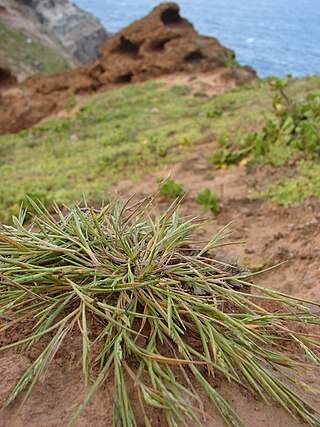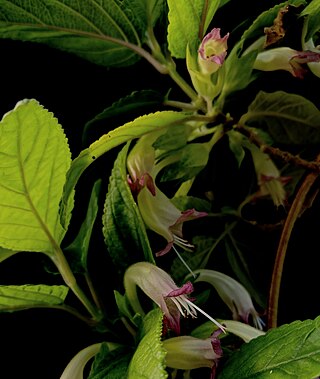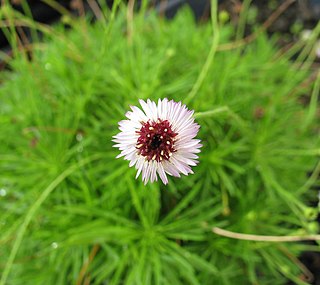
Cenchrus agrimonioides is a rare species of grass in the family Poaceae that is endemic to the Hawaiian Islands. Its common names include Kāmanomano and agrimony sandbur. It was formerly distributed throughout the major islands but today it is nearly limited to Oʻahu. Kāmanomano inhabits dry to moist forests and lava plains. It is threatened by competition with non-native plants, predation by ungulates, and wildfire. When this plant became a federally listed endangered species of the United States in 1996 there were fewer than 100 individuals remaining. More recent counts revealed 181 wild individuals on Oʻahu and over 300 more which have been planted to augment the populations. This plant is nearly restricted to the island of Oʻahu, but there are a few individuals known on Maui. A few patches of the grass have been planted on Kahoʻolawe, as well.

Sclerocactus brevihamatus is a species of cactus known by the common name shorthook fishhook cactus.

Euphorbia skottsbergii is a rare species of flowering plant in the euphorb family known by the common names coastal sandmat and Skottsberg's broomspurge. It is endemic to Hawaii, where it is found in coastal shrublands on Oʻahu, Molokaʻi, Maui, and Kahoʻolawe. Like other Hawaiian euphorbs, this plant is known locally as ʻakoko.

Escobaria sneedii is a rare species of cactus known by the common names Sneed's pincushion cactus and carpet foxtail cactus. It is native to the Chihuahuan Desert, where it occurs in scattered locations in New Mexico, Texas, and Chihuahua. Some plants occurring in Arizona may be included within this species. Botanical authors do not necessarily agree on the circumscription of this species. Most will agree at this point in the research, however, that there are two varieties of Escobaria sneedii, and that both are rare and endangered. The plant is popular with cactus enthusiasts and dealers because of its often petite size and tolerance for moderately cold climates. They have been overharvested from their natural habitat, the main reason why the two varieties, var. sneedii and var. leei, have been federally listed as endangered and threatened, respectively.
Cyanea koolauensis is a rare species of flowering plant in the bellflower family known by the common names Palolo Valley rollandia and narrowleaf rollandia. It is native to Oahu, where it is known only from the Koʻolau Mountains. It is a federally listed endangered species. Like other Cyanea it is known as haha in Hawaiian.
Dryopteris crinalis is a species of fern known as the serpent woodfern. It is endemic to Hawaii, where it is known from the main islands.

Echinocactus horizonthalonius is a species of cactus known by several common names, including devilshead, turk's head cactus, blue barrel cactus, eagle's claw, horse maimer, horse crippler, and visnaga meloncillo. It is native to the southwestern United States and northern Mexico, where it occurs in Chihuahuan Desert and Sonoran Desert habitats, particularly on limestone substrates. One of its varieties is a federally listed endangered species of the United States.
Kadua cookiana is a rare species of flowering plant in the coffee family known by the common names 'awiwi and Cook's bluet. It is endemic to Hawaii, where it is known only from Kauai, having been extirpated from Molokai and Hawaii. It is a federally listed endangered species of the United States.

Lipochaeta lobata is a species of flowering plant in the family Asteraceae known by the common name shrubland nehe. It is endemic to Hawaii, where it can be found in coastal dry shrublands and dry forests on Oʻahu, Maui, and Niʻihau.
Melicope munroi is a rare species of flowering plant in the family Rutaceae known by the common names lanahale and Munro's pelea. It is endemic to Hawaii, where it is known only from the island of Lanai. It is a federally listed endangered species of the United States. Like other Hawaiian Melicope, this species is known as alani.

Panicum fauriei is a species of grass known by the common name Faurie's panicgrass. It is endemic to Hawaii.
Phyllostegia hirsuta is a species of flowering plant in the mint family known by the common names Molokai phyllostegia and hairy phyllostegia. It is endemic to Hawaii, where it is known only from the island of Oahu. It is a federally listed endangered species of the United States.

Phyllostegia parviflora is a rare species of flowering plant in the mint family known by the common name smallflower phyllostegia. It is endemic to Hawaii, where it is known from Maui, Oahu, and the island of Hawaii. It is a federally listed endangered species of the United States.
Schiedea spergulina is a rare species of flowering plant in the family Caryophyllaceae known by the common name canyon schiedea and spreading schiedea. It is endemic to Hawaii, where it is known only from the island of Kauai. It is threatened by the degradation and destruction of its habitat. There are two varieties of this plant, one federally listed as an endangered species of the United States, and the other listed threatened.
Stenogyne bifida is a rare species of flowering plant in the mint family known by the common name twocleft stenogyne. It is endemic to Hawaii, where it is known only from the island of Molokai. In 2010, there was only a single individual remaining in the wild; this is a seedling. It is a federally listed endangered species of the United States.

Stenogyne kanehoana is a rare species of flowering plant in the mint family known by the common name Oahu stenogyne. It is endemic to Hawaii, where it is known only from the Waianae Range on the island of Oahu. It is a federally listed endangered species of the United States.
Stenogyne kealiae is a rare species of flowering plant in the mint family known by the common name Keal's stenogyne. It is endemic to Hawaii, where it is known only from the island of Kauai. It was federally listed as an endangered species of the United States in 2010.
Tetramolopium arenarium is a rare species of flowering plant in the family Asteraceae known by the common name Maui tetramolopium. It is endemic to Hawaii, where it is known only from the island of Hawaii. It is extirpated from Maui. It is threatened by the degradation of its habitat. It is a federally listed endangered species of the United States.

Tetramolopium filiforme is a rare species of flowering plant in the family Asteraceae known by the common name ridgetop tetramolopium. It is endemic to Hawaii, where it is known only from the Waianae Mountains on the island of Oahu. It is threatened by habitat degradation caused by feral goats and introduced species of plants. It is a federally listed endangered species of the United States.

Erigeron maguirei is a species of flowering plant in the family Asteraceae known by the common names Maguire daisy and Maguire's fleabane. It is endemic to Utah in the United States. It is a perennial herb growing up to 28 centimetres tall. It grows from a taproot and a branching caudex. The stems are densely hairy. The inflorescence holds one to five flower heads each with several hairy, glandular phyllaries. The head has up to 20 white, pink-tinged, or pink ray florets 0.6 to 0.8 centimeters long, and many yellow disc florets at the center.











